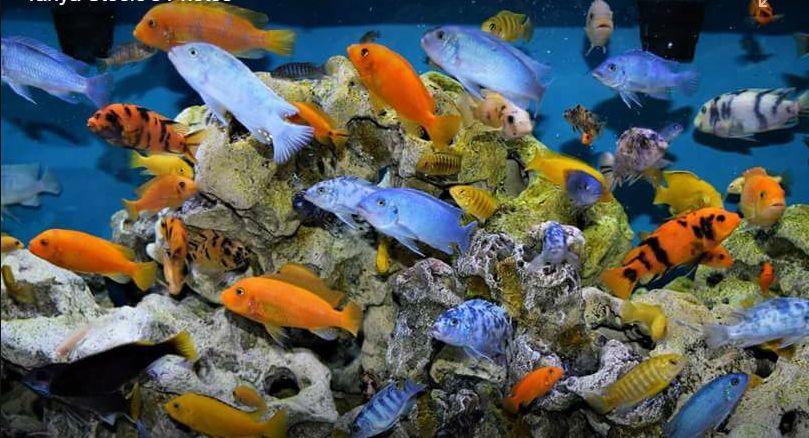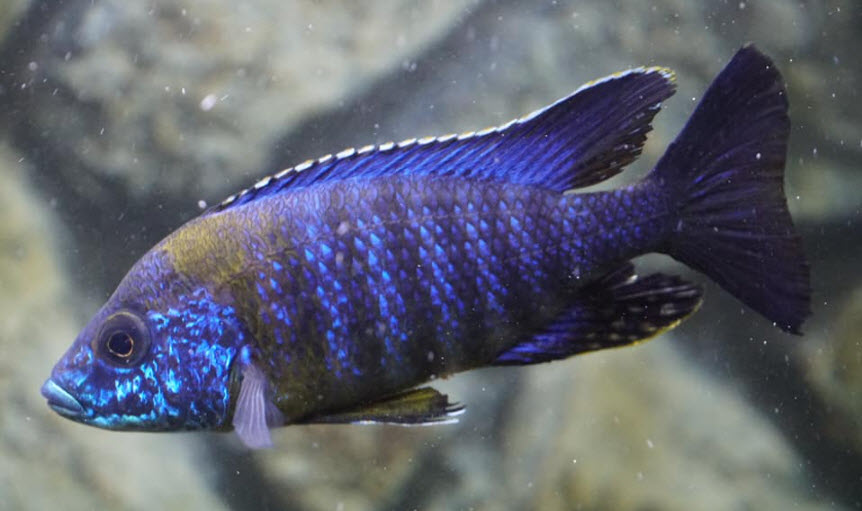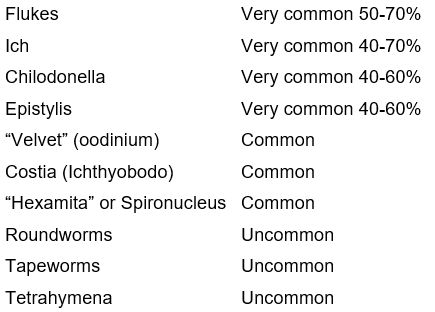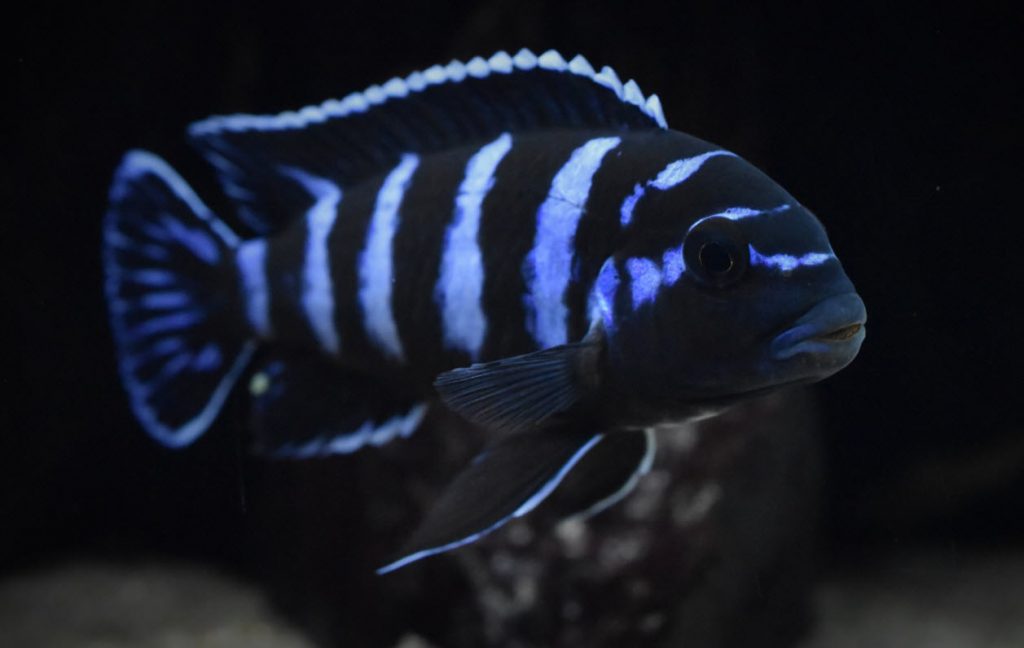
Fish die. If you have heavily stocked tanks fish die all the time. And easily 50% of the time even the best facilities like Cornell or the University of Florida can examine the fish and cannot tell you what the fish died from. Most fish diseases are subtle. And most diagnoses of fish diseases are “best guesses” at best.
So what are the most common diseases of aquarium fish? Aquarium fish diseases include the following:
- Protozoan external parasites
- “White spots” or ich (Ichthyophthirius multifiliis protozoan)
- “Velvet” (Piscinoodinium pillulare, or oodinium, a dinoflagellate algae)
- Epistylis (a ciliated protozoan)
- Costia (Ichthyobodo, a protozoan)
- Chilodonella (a ciliated protozoan)
- An assortment of protozoan diseases like Costia
- Cryptobia
- Aggression (not really a disease but often mistaken for Chilodonella or costia)
- Bacterial Diseases
- “Saddleback”
- Tail rot
- Mouth rot
- Duck lips
- Gill disease
- Red/brown patches of skin (red pest)
- White eye
- Popeye
- Ulcers
- Fish TB (Mycobacteriosis)
- “Internal parasites” (“Hexamita” or Spironucleus)
- Saprolegniasis (“Fungus”)
- Lymphocystis
- Flukes
- Black Spot
- Roundworms (Camallanus)
- Tapeworms
- Anchor Worms

Diana Walstad (author of the book “The Ecology of the Planted Aquarium”), did an extensive literature search and found that the following organisms were found on fish in tropical fish shipments from Southeast Asia at the following levels:

Since we know most bacteria and TB are found in virtually all aquariums this illustrates the difficulty in keeping out all pathogens from a fish aquarium. It also illustrates the importance of keeping the immune systems of the fish in top notch condition to prevent these diseases from breaking out.
The mechanism by which these organisms survive is very logical from an evolutionary standpoint. Most of these pathogens occur at a very sub-lethal level in many fish. If one of these pathogens became 100% lethal, or even close to 100% lethal, the host fish would die, and the pathogen would lose the host which is nurturing it while the pathogen makes millions of new organisms. So, the organism would die out along with its host. This would not be advantageous to any given organism. So, pathogens with 100% fatalities are very rare and even 20% lethality is stretching it with most pathogens.

.
Don’t Go Down a Rabbit Hole
It is very common to get very involved with a long line of logic about a fish dying. This can easily put one “down a rabbit hole”. In general, it is best to look for the simple explanation. The best way to illustrate that is to delve into one YouTube video.
Ben Ochart had the following sequence of events happen:
1, action: He took in a new fish that had supposedly suffered from some aggression and had tattered fins. He put it in an existing aquarium.
His conclusion: The fish was healthy and didn’t need quarantining
2, action: He had some blocked cartridge filters, so he replaced all the cartridges at the same time he added the new fish.
His conclusion: He removed most of his beneficial bacteria
3, action: He added some Fritz Maracyn antibiotic to the water in the tank with the new fish to treat the tattered fins
His conclusion: The antibiotic killed the small number of beneficial bacteria remaining
4, action: The water turned cloudy and the fish in the tank appeared to be in distress, being up at the surface and “panting”. He did a 50% water change.
His conclusion: His filter cleaning had killed off the beneficial bacteria and this was putting his fish in distress.
5, action: The next morning four large, prized fish were dead. He tested the water for ammonia and it was zero.
His conclusion: He had had a sudden “unseen” ammonia spike and that had killed his fish.
6, action: He added some cycled filter media to the filters and added Fritz bottled bacteria and no more fish died.
His conclusion: He felt he made four mistakes: not quarantining, replacing the cartridges, adding the antibiotic, and not adding bottled beneficial bacteria soon enough.

I found this whole sequence just kind of sad, especially since Ben is such a likable guy. It was SO preventable. Ben made two mistakes: he didn’t quarantine a fish (note this is the SECOND time Ben has had a disease outbreak which killed a lot of fish because he failed to quarantine…. Ben … Ben …. Ben ….!) and he put the antibiotic into the water and not into the food.
The fish he added had a bacterial infection. The bacterial infection killed four of his prized fish very rapidly. Simple. Easy.
Changing all his cartridges at once was not a good idea but it had nothing to do with his fish dying. Ammonia is a slow poison that kills fish slowly over weeks. It does not kill overnight. And if it somehow did get high enough to kill the fish the spike certainly wouldn’t disappear before morning.
The cloudy water was also harmless. And cloudy water is NOT caused by ammonia. Maracyn antibiotic is insoluble in water and caused the cloudiness. The bacterial infection was in the gills of the fish, causing them to pant at the surface.
And the bacterial infection just died out on its own. The bottle bacteria and cycled filter media had nothing to do with it going away.
The take away here is to always look for the simplest explanation. Don’t get all caught up in trying to get a long line of causation. You will probably end up being wrong.

Return to Diseases Menu
.
Aquarium Science Website
The chapters shown below or on the right side in maroon lead to close to 400 articles on all aspects of keeping a freshwater aquarium. These articles have NO links to profit making sites and are thus unbiased in their recommendations, unlike all the for-profit sites you will find with Google. Bookmark and browse!
.

Dave says
In reply to Dena … I would hit them with Kanamycin in a pipette down the throat (Maracyn 2 [not Maracyn] is better but you have kanamycin so go with that). Medication needs to get inside the fish to be effective. I suspect bacterial gill infection. You have to pipette it or bath it (shallow bath where fish flops around a lot, swallowing a strong bath of the medication) as they are not eating. http://aquariumscience.org/index.php/11-15-fish-not-eating/
Dena Winchester says
Thank you for all this information! I have mostly discus fish (29) in my 4 aquariums (plus 2 hospital tanks) and do not encounter illness very often. All tanks have UV sterilizers and either FLUVAL FX 4 or FX 6 (except my Red Sea). I had 1 unexplained and sudden death about 2 months ago. Then, about 4 weeks ago, I noticed 2 in my 150g with gill hyperplasia and tachypnea. I immediately thought flukes? Since I don’t routinely de-worm my tanks, I decided to use Absolute Plus dewormer. After a couple days, there was no change in the 2, so I plopped them into my 37g hospital tank. I treated with aquarium salt and pure Praziquantel, waited 5 days, repeated Praziquantel. No change. Continued with daily water changes (aged RO with Discus Trace) and aquarium salt. The discus became less active, hiding in a back corner, appetites decreasing. I administered Potassium Permanganate treatment. Nope, that didn’t help. I continued with daily water changes and aquarium salt, giving them a break while I contemplated my next move. And they continued to worsen. No longer eating or swimming at all. So I pulled out my trifecta. Pure Metro, Nitro and Kanamycin. I did this for 4 days. And still, no improvement. The smaller dark angel discus was now becoming pale white and skinny as a razor. The blue heckel has become very dark, losing weight but not as skinny because he started out huge. Yesterday evening, I thought the dark angel would be dead soon, as his frail body was now curving into the current. As a last ditch effort, I moved him into my 15g hospital tank. I decided to try Tetra Lifeguard along with a Hail Mary. I added 1 tab to ‘start off slow’. Hmm. He began to swim around, leisurely exploring the new surroundings. Within 3 hours, his white dorsal fin became blue again and he began to regain some of his color. Interesting. I calculated the amount of ‘actual’ water, and determined it to be 13.6 gal. So I added another Lifeguard tablet. Since he seemed to improve so much, I began to add Lifeguard to the 37g tank with the heckel. I added slowly, again. This morning, I gave the dark angel the other 1/2 tab, and the heckel the last 1 1/2 tabs. The heckel has not shown any significant improvement and remains dark and hiding towards the bottom of the tank. The dark angel has his normal color again, but not swimming and is in a back corner.
So, I just keep doing the best I can and should these 2 get much worse, I will probably end up euthanizing with clove oil followed by liquor. This is the most difficult for me as I end up crying through the whole process, apologizing to my fish for not being able to help. I am an RN of several decades,, working full time for a healthcare system that owns several hospitals. I am an ‘in-house specialty traveler’, meaning, I am an employee of the company who works full time and ‘travels’ (gets sent to) ANY of their emergency depts (my specialty…. emergency medicine) where they are short staffed. So I guess you could say I work full time in multiple ED’s in the ‘Valley of the Sun ” (ie Phoenix). As such, I work as hard for my fish as I do for my patients.
Thank you, again, for these inpotartant informational reports. I’m sure I will read every single one and will keep them in my ‘database’ for discus/fish care..